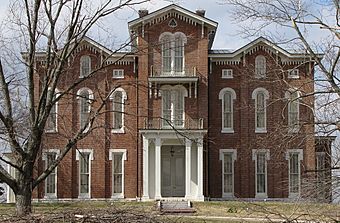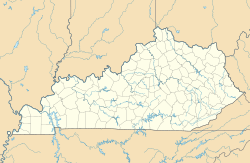White Hall State Historic Site facts for kids
Quick facts for kids |
|
|
Whitehall
|
|

White Hall in 2009
|
|
| Location | 500 White Hall Shrine Road |
|---|---|
| Nearest city | Richmond, Kentucky |
| Area | 13.6 acres (5.5 ha) |
| Built | 1799 |
| Architect | Gen. Green Clay; Thomas Lewinski |
| Architectural style | Italianate, Georgian |
| NRHP reference No. | 71000352 |
| Added to NRHP | March 11, 1971 |
White Hall State Historic Site is a 14-acre park located in Richmond, Kentucky. It is southeast of Lexington. This historic place was once home to important Kentucky leaders. These included General Green Clay and his son, General Cassius Marcellus Clay. Famous women's rights activists, called suffragists, Mary Barr Clay and Laura Clay, also lived here.
On April 12, 2011, White Hall received a special honor. It was named a national historic site in journalism. This was because of Cassius M. Clay's work as a newspaper publisher.
Contents
Discovering White Hall: A Historic Home
White Hall is the main feature of the site. It was the home of Kentucky politician Cassius Marcellus Clay and his wife, Mary Jane Warfield Clay. Cassius M. Clay was a strong supporter of ending slavery. He published an anti-slavery newspaper. He was also a politician, a soldier, and served as an Ambassador to Russia. He worked in this role during the presidencies of Lincoln, Johnson, and Grant. His newspaper, True American, was published for almost 25 years.
This large, restored house has 44 rooms and is built in the Italianate style. It started as a smaller, 8-room house. General Green Clay built it in 1798–1799 in the Georgian style. He called it Clermont. Later, Mary Jane Warfield Clay oversaw the expansion of Clermont. It became the grand house we now know as White Hall. Thomas Lewinski was the architect for this big change. The Georgian style was updated to the Italianate style. The renovation was very expensive, costing about $40,000 at the time. Clermont originally faced south, but the new entrance of White Hall was moved to face east.
White Hall was also special for its advanced indoor plumbing. Rainwater was collected from the roof into a tub. This water then flowed down to a toilet and a copper bathtub. This was very modern for its time.
The White Hall property also has two other buildings. The kitchen was built around 1790 when Green Clay owned the land. It served as the main kitchen for Clermont. Food was carried from there to a warming kitchen in the main house. This kitchen has what is thought to be the largest fireplace still existing from the 19th century. The larger of the two buildings was used as living quarters for the enslaved people who worked on the White Hall estate.
Important People Who Lived Here
White Hall was home to several important figures in Kentucky history.
Green Clay: Early Kentucky Pioneer
General Green Clay was the first owner of the property. He built the original house, Clermont. Clay was one of the first settlers in Kentucky. He worked as a land surveyor. He earned his wealth by keeping a part of the land he surveyed as payment. By the time he passed away, Green Clay was one of the largest land and slave owners in Kentucky.
Cassius M. Clay: A Champion for Freedom
Cassius M. Clay was a Kentucky politician. He was known as an emancipationist, meaning he supported freeing enslaved people. This was unusual for someone of his background at that time. Clay even fought duels to defend his beliefs. He served in the Mexican War and was celebrated as a hero when he returned. Clay published an anti-slavery newspaper called The True American. He later had to move its printing to Cincinnati, Ohio. He was also one of the early founders of the Republican Party.
During the American Civil War, Clay served as President Lincoln's Ambassador to Russia. While he was in Russia, his wife, Mary Jane Warfield Clay, oversaw the transformation of Clermont into White Hall.
The Clay Daughters: Leaders for Women's Rights
Cassius M. Clay's daughters, Mary Barr Clay, Sally Clay, and Laura Clay, also lived at White Hall. Mary Barr Clay was an early supporter of women's right to vote, known as women's suffrage. She greatly influenced her younger sisters, especially Laura. Laura Clay became a major leader in the women's suffrage movement. She was even the first woman ever nominated for a major political party's presidential ticket.
Saving and Restoring White Hall
Members of the Madison County Garden Club helped lead the effort to save this historic home. They worked with many Kentucky historical preservation groups. Governor Edward Breathitt agreed to buy White Hall from its owners. In 1968, the heirs of Cassius M. Clay sold the land around White Hall to the state of Kentucky for $18,000. The house itself was donated. White Hall became part of the state park system in 1968.
The house's restoration was finished in 1971. It then opened to the public. Kentucky's First Lady Beula C. Nunn led this project. She had help from the Kentucky Mansions Preservation Foundation.
In February 2019, the Eastern Kentucky University Board of Regents voted to take over White Hall State Historic Site. The State of Kentucky agreed to pay EKU $50,000 for two years. This money was to help with any unexpected costs of owning the property. EKU plans to use the building as a real-world learning place for its Department of Recreation and Park Administration students.
Treasured Family Items Donated to White Hall
After Cassius M. Clay passed away, an estate sale was held at White Hall on October 8, 1903. Records of who bought furniture were kept. This list helped track down items to bring them back to White Hall.
Cassius M. Clay's original document appointing him as US Ambassador to Russia was donated by Bruce Ferguson. This important paper has President Abraham Lincoln's signature. It is now on display at White Hall State Historic Site.
Two tapestry rugs and a Louis XV table were donated by Annabell Olsen of Somerset, Kentucky. These items once belonged to Green Clay and Cassius M. Clay. The tapestry rugs are very old, from the Ming Dynasty, before 1300. Their blue, red, and gold colors have faded over time. Olsen found the rugs hidden in a stove pipe in the White Hall kitchen. They were likely placed there to keep out soot when the wind blew.
The Louis XV table was a gift to General Green Clay from General Lafayette. Green Clay met Lafayette when he visited Europe for the Continental Congress. Cassius M. Clay valued this table so much that he would not let anyone touch it. When a leg broke, Clay was so worried that he fixed it himself. The table is about 36 inches wide and as tall as a modern coffee table. It is painted olive green, brick red, and gold. The type of wood under the paint is not known.
Pieces of a china set that belonged to Cassius M. Clay were also donated. Mrs. William C. Benton of Denver, Colorado, gave these items. This china is part of the original 104-piece set Clay used as Ambassador to Russia. The plates have a gold design in the center. Their outer rim is decorated with bands of gold and magenta. Other pieces of this set were already on display at White Hall.
A bed that once belonged to Brutus Junius Clay II was donated by Cecil Salter. Salter's father, Samuel, bought the bed at an auction. Brutus Junius Clay II was the son of Cassius M. Clay. Junius became well-known for serving as a commissioner to the Paris Exposition in 1900. He then served as US Ambassador to Switzerland from 1905 to 1912. Junius also donated land in Richmond, Kentucky, to create the first hospital in Madison County. He did this in memory of his wife, Pattie A. Clay.



